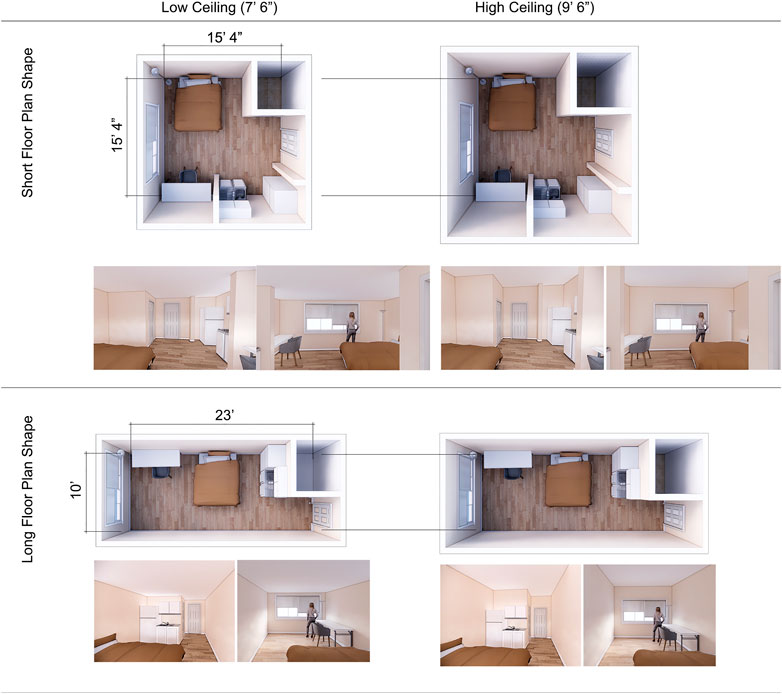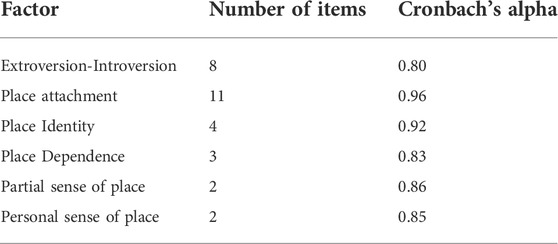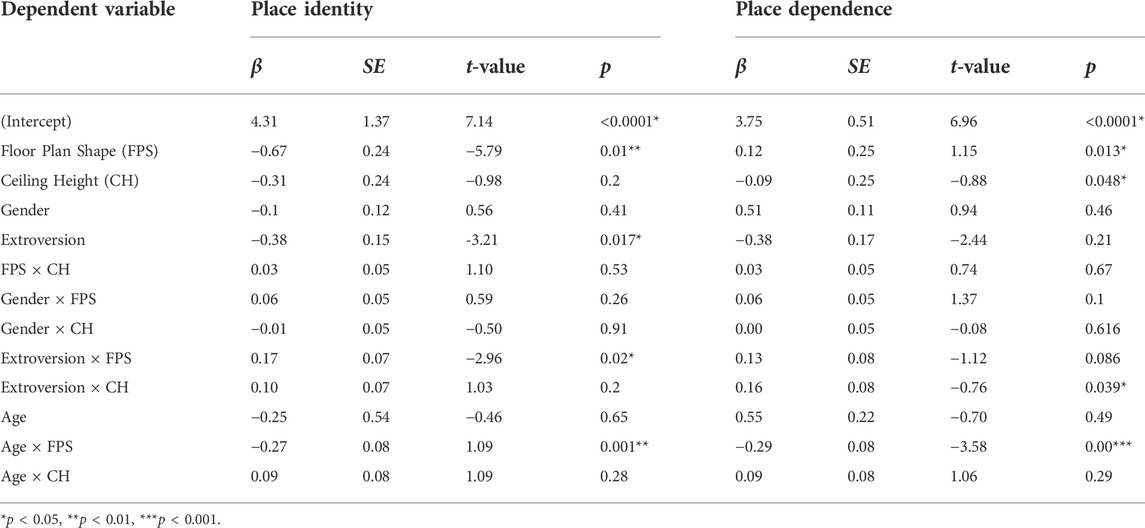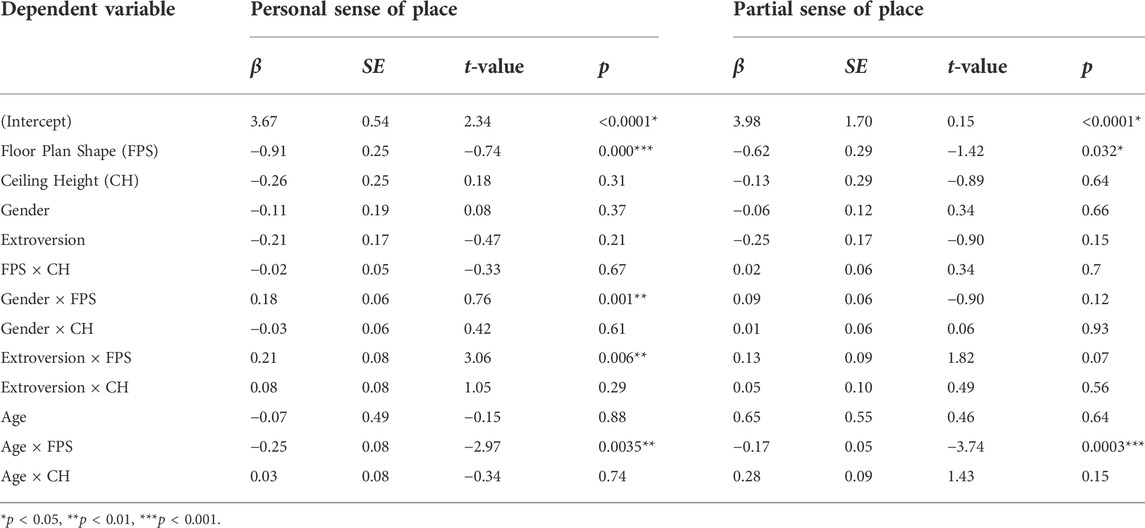- Department of Human Ecology, Cornell University, Human-Centered Design, Ithaca, NY, United States
Virtual reality (VR) technology has been used as a design research tool to enable a virtual experience of space as a real-life-scale mock-up. In terms of user experience design research, VR is highly scalable and adjustable, meaning that designed virtual prototypes and environments can be tested on a diverse population without restrictions. In spatial design, VR has been applied in various contexts, often focusing on behavioral intentions and psychological perceptions. Small living spaces are gaining more popularity as an affordable housing solution and an environmentally sustainable lifestyle. Despite their growing demand, user experiences of small living spaces have not been empirically tested. Specifically, the impact of users’ different characteristics on the psychological responses to small living spaces has rarely been studied. In this study, we used three-dimensional (3D) virtual mock-ups to test how subjects of different genders and personality types perceived different shapes of a small space. A 2 × 2 factorial design was used to test two different wall length-width combinations (short vs. long floor plan shape) with two different ceiling heights (low vs. high). Forty-eight participants were randomly assigned to watch one of the four small living spaces. After watching the virtual walkthrough video, participants filled out the questionnaires on their perceptions. The results show that floor plan shape had a significant impact on place attachment. Participants reported greater place attachment to the space with a shorter floor plan than the longer one. In addition, higher ceiling height is closely related to functional and goal-oriented connections. The impact of the floor plan shape of the space on place attachment differed according to gender, age, and personality. Participants with higher extrovert scores reported greater functional connections to higher ceiling height. Men reported significantly more affective ties with longer floor plans than shorter ones. The older age group perceived longer floor plans to be more functional than the shorter ones.
1 Introduction
Perceptions of the home environment have changed due to the pandemic. More people are spending more time at home due to remote work and virtual collaboration. With greater time spent at home, providing a comfortable and pleasant living space has become more crucial.
Small living spaces can be defined as any structure less than 400 square feet, excluding a loft (ICC, 2018). The average size of a tiny house for sale in the United States is 225 square feet, or roughly one-eighth the size of a typical home (Olick, 2018). The living spaces in a tiny home village, developed by several U.S. cities as shelters for the homeless, are as small as 8 feet, 6 inches by 7 feet, 6 inches, or 64 square feet.
Problems and questions arise as small living spaces become an emerging housing trend. Before making decisions, stakeholders such as policymakers and developers must understand experiences with diverse housing options. Small living spaces are becoming a vital housing option and are inextricably linked to our society’s current problems, especially with the pandemic and increasing homelessness. In the United States, social phenomena such as tiny houses on wheels (THOW) and tiny home movements accurately reflect recent housing trends. In addition, small living spaces are being presented as an affordable housing alternative that could be one of the solutions to the United States and many other countries homelessness problems (Evans, 2018; Jackson, 2020).
Despite the growing importance of and interest in small living spaces, there is a dearth of academic studies on how design and size affect people’s perceptions of small living spaces (Krista, 2018; Mangold and Zschau, 2019; Penfold et al., 2019; Evans, 2021; Shearer and Burton, 2021). Some case studies of small living spaces have been conducted in a specific physical environment (Evans, 2021). However, experimental studies in a physical environment are expensive, and it is challenging to manipulate the physical attributes of the environment.
A second-best approach after the real space is to use a virtual mock-up tool that employs virtual reality (VR) technology, which has rarely been used to study small living spaces. Compared with physical environments, virtual environments are easier to adjust. By rendering different environmental designs with VR, researchers and stakeholders can better understand people’s perceptions of the spaces. This study aims to explore the psychological effects of ceiling height and floor plan shape on perceptions of small living spaces. The study presents the possible application of VR as a design research tool. In addition, the study’s findings should suggest a more comfortable design for small affordable homes or refuge shelters.
1.1 Ceiling height and floor plan shape in small spaces
The importance of spaciousness to human well-being has been recognized in several studies. Specific environmental properties, such as floor plan layout, spatial depth, color, lighting, and ceiling height, were found to have significant effects on residential satisfaction and the perceived spaciousness of a room (Evans et al., 2003; Stamps, 2011; Rollings & Evans, 2019). Floor layout and ceiling height were especially crucial in the perceived openness of spaces and led to feelings of spaciousness. Spatial depth has been defined as the number of rooms and areas that one needs to pass through to move from one point in a structure to the opposite end (Evans et al., 1996).
In the current study, the term floor plan shape describes different wall length-width combinations when the total square footages are equal; a square-like floor plan is referred to as having a short shape, whereas a rectangular one has a long floor plan shape. The floor plan shape and ceiling height need to be determined by the earliest design development phase and are nearly impossible to modify after construction; thus, it is critical to understand the target residents’ responses.
Ceiling height and space dimensions are considered crucial for a spacious look and feel. Higher bedroom ceiling height can reduce negative perceptions of the home (Rollings and Evans, 2019). Wider floor plans tend to look more open than linear floor plans (Brookes and Kaplan, 1972). In the case of an office setting, the arrangement of office layout features influences workers’ perceptions of the office (Zerella et al., 2017). Studies reported that an open floor plan helps coworkers communicate better and increases the sociability among the groups (Hundert, 1969; Broo; kes and Kaplan, 1972; Allen and Gerstberger, 1973; Zahn, 2016). However, open floor plans could add more distractions, noise, and disturbances for occupants with sensory overload (Brookes and Kaplan, 1972). Increased spatial depth has been found to have a moderating impact on reduced negative social feelings and psychological distress. Evans et al. (1996) found that people living in greater spatial depth experienced less harmful effects from crowding because they have more alternatives when regulating social interactions.
1.2 Gender, personality, and spatial perception
Gender is one of the most researched concepts in the field of environmental psychology. For instance, men and women differ in their responses to crowding situations, with women tending to handle crowding issues better than men (Gifford, 2007). In terms of personal space and territoriality, men prefer larger interpersonal spaces than women (Gifford et al., 2011). In addition, regardless of race, males desire a higher level of privacy than females do (Kaya and Weber, 2003). Concerning degree of enclosure, girls prefer closed structures more than boys (Lowry, 1993).
Personality is the unique pattern of traits related to the way people behave, feel, and think (Pervin and John, 1999; Gifford, 2007). Personality plays a crucial role in the field of environmental psychology (Gifford, 2007). Understanding personality could help people understand and predict environmentally relevant behaviors (Gormly, 1983).
Differences in personality could explain individuals’ perceptions of the environment (Jung, 2016). The perception of an environment is closely related to what one wants to see and look for in the environment. Personality and physical settings influence behavior and one’s attitude toward the environment (Zerella et al., 2017; Yadegari and Alinaghi, 2020). In other words, personality influences behaviors and attitudes in diverse environments such as social spaces (Gifford, 2007) and workplaces (Wells and Thelen, 2016).
Among diverse personality models in the field of psychology, the Big Five personality traits model (Barrick and Mount, 1991) is one of the most widely used in research. It classifies human personalities into five dimensions: extroversion, agreeableness, neuroticism, conscientiousness, and openness (Digman, 1990). For this study, we adopted the extroversion-introversion dimension known to have a strong correlation to the feeling of sense of belonging to a space (Yadegari and Alinaghi, 2020). Previous studies reported that people who are extroverted, warm, and affiliative tend to prefer smaller personal spaces than people who are introverted (Gifford, 2007).
1.3 Place attachment: Place dependence, place identity, sense of place
Place attachment has been extensively studied in environmental psychology (Kaltenborn, 1997; Kyle, 2004; Raymond, Brown and Weber, 2010; Li and Han, 2021). It is a cognitive and emotional bond that individuals develop toward places (Hidalgo and Hernández, 2001; Gifford, 2007; Scannell and Gifford, 2017). In other words, place attachment is the feeling of connection to a place that is meaningful to a person (Scannell and Gifford, 2017).
Place attachment has been adopted in several social and behavioral science studies as a measure of emotional attachment in large-scale places such as a country or small-scale places such as a bedroom (Raymond et al., 2010; Gifford, 2014). Place attachment has been defined in diverse ways in different fields (Raymond et al., 2010), but usually, it has been operationalized with subdimensions such as place identity, place dependence, and sense of place (Kaltenborn, 1997; Kyle, 2004; Raymond et al., 2010; Li and Han, 2021). These subdimensions all explain the bonds and connections between spaces and people (Hidalgo & Hernandez, 2001). In this study, frameworks explained by Raymond and Gifford were adopted to understand small living space experiences (Raymond et al., 2010; Gifford, 2014).
Place identity refers to one’s incorporation of a place into the larger concept of self (Gifford, 2007). It is the dimensions of the self that define a person’s identity in relation to the environmental setting (Raymond et al., 2010). Place identity involves the feelings about specific physical environments and connections to place (Proshansky et al., 1983). Place dependence is defined as the functional or goal-oriented connections to the setting (Raymond et al., 2010). Stokols and Shumaker (1981) define place dependence as the perceived association between a person and specific places. According to Schreyer et al. (1981), place dependence refers to connections based specifically on activities that take place in a setting for the intended use. The personal sense of place is an individual’s affective ties to a place (Gifford, 2007). Partial sense of place includes positive feelings without any commitment to stay. Personal sense of place is a more stable bonding that long-term residents develop (Gifford, 2007).
Considering the commonly reported psychological benefits of place attachment (Scannell and Gifford, 2017), this study adopts the concepts of place attachment, place identity, place dependence, personal sense of place, and partial sense of place to measure perceptions and experiences with small living spaces. The link between an individual’s attachment to home and positive psychological effects (Scannell and Gifford, 2017; Meagher and Cheadle, 2020) has been established. In this study, we use place attachment as a construct for small space perceptions with the potential for long-term experiences for occupants.
1.4 Virtual reality as a design research tool
VR environments are used for research in architecture, landscape architecture, and environmental planning (Portman et al., 2015). VR is a helpful research tool for studying the impact of environmental design features that are otherwise challenging to examine in real life. For instance, simulating urban and natural virtual environments enabled researchers to efficiently examine the impact of specific environmental features (Baistatou et al., 2022). Another benefit is that VR provides a controlled research environment (Neo et al., 2021). Doggett and others studied acoustic interventions that could be easily distracted by external noises in a constrained virtual environment (Doggett et al., 2021). A more accurate experiment was possible in VR by controlling other distracting factors.
With these strengths, VR is considered an innovative design research method that quantifies changes in psychological, cognitive, and behavioral experiences. Therefore, we used VR-simulated small living spaces with different spatial design elements, which could be difficult and costly to test in real-life environments.
1.5 Research questions and hypotheses
The main purpose of this study was to examine whether place attachment of small living spaces was influenced by 1) ceiling height and floor plan shape and 2) individual traits, such as gender, age, and personality. On the basis of the literature review, ceiling height and floor plan shape were chosen as the spatial design elements.
1.6 Research Model of Study
This study examines the following research questions and hypotheses (Figure 1):
Research Question 1:. In the context of small living spaces, do floor plan shape and ceiling height affect place attachment?
• H1-a. Compared with low ceiling height, high ceiling height will have a positive impact on place attachment ratings.
• H1-b. Longer floor plan shape will be associated with higher place attachment ratings than short floor plan shape.
Research Question 2:. Do demographic variables such as gender, age, and personality moderate the relationship between spatial design elements (i.e., ceiling height and floor plan shape) and place attachment?
• H2-a. The effect of ceiling height on place attachment will differ depending on gender, age, and personality (extroversion-introversion).
• H2-b. The effect of floor plan shape on place attachment will differ depending on age, gender, and personality (extroversion-introversion).
2 Methods
2.1 Virtual stimuli
This study uses 3D virtual mock-ups to examine the influence of two spatial design variables-floor plan shape (short, long) and ceiling height (low, high)-on place attachment. In addition, we examine the potential role of gender, age, and personality as moderators of the spatial variables on place attachment.
Four virtual simulation settings rendered as 3D walkthrough videos were created using SketchUp with Enscape, a 3D real-time high-fidelity rendering plug-in. In these videos, four different small living spaces were shown in two variations each. Each was shown with two different ceiling heights and floor plan shapes. All four spaces contained a bathroom, a kitchen, and a bedroom/living room area (Figure 2).
2.2 Four Small Space Conditions
To explicitly examine the impacts of ceiling height and floor plan shape on room perceptions, the area of the rooms was held constant at 236 square feet. The dimensions of the short room were set as 15 feet, 4 inches by 15 feet, 4 inches, and those of the long room were set as 10 feet by 23 feet, 6 inches. The same interior elements such as furniture, color, material finishes, equipment, and lighting fixtures were used in all spaces.
2.3 Subjects and data collection
A total of 48 participants, of whom 26 were men, and 22 were women, were recruited through the Amazon Mechanical Turk website and from an online participant recruitment tool on a university campus. Participants’ ages ranged from 18 to 59 (Table 1). No criteria or additional qualifications for participants were specified in the recruitment announcement.
2.4 Constructs and measures
Scales were developed to measure viewers’ perceptions of the virtual environments by referring to the concepts of place attachment, place identity, place dependence, and sense of place (Kaltenborn, 1997; Kyle, 2004; Li & Han, 2021; Raymond et al., 2010; Sampson and Goodrich, 2009).
Place Attachment. The place attachment scales were adapted from previous studies (Kaltenborn, 1997; Kyle, 2004; Gifford, 2007; Raymond et al., 2010; Li & Han, 2021). Given that place attachment was often studied in the context of natural community residential settings, scales were modified for the virtual environment. Place attachment is operationalized via four subscales (Table 2). To assess place attachment, items from previously published measures were included (Lies et al., 2017; Kaltenborn, 1997; Raymond et al., 2010). Scales of place dependence and place identity were adopted from two papers (Lies et al., 2017; Raymond et al., 2010), and personal sense of place and partial sense of place were adopted from previous studies (Lies et al., 2017; Kaltenborn, 1997; Sampson and Goodrich, 2009). Scannell and Gifford also took a similar approach in that they adopted place attachment questionnaires from several previous studies (Scannell and Gifford, 2011).
The place attachment scale used in this study consists of 11 items and four subscales: place identity (4 items, e.g., “I identify strongly with this room.”), place dependence (3 items, e.g., “This room is a good place for the activities I like to do.”), partial sense of place (2 items, e.g., “I am very emotionally attached to this room.”), and personal sense of place (2 items, e.g., “I am willing to come back to this room.”). We asked participants to answer each question on a 5-point Likert-type scale (1 = strongly disagree to 5 = strongly agree).
Extroversion-introversion personality traits were identified for each participant. To measure extroversion-introversion personality traits, the question items from the Big Five personality survey were adopted (Rammstedt and John, 2007). With the extroversion and introversion scale, higher scores indicate higher extroversion, and lower scores indicate lower extroversion (i.e., introversion). Rammstedt and John’s personality scale questionnaires have been frequently adopted from previous studies (Li, 2018; Lee et al., 2019; Terzis et al., 2012). Personality scales consist of eight items (e.g., “I see myself as someone who is talkative,” “I see myself as someone who tends to be quiet,” “I see myself as someone who generates a lot of enthusiasm”). We asked participants to answer each question on a 5-point Likert scale (1 = strongly disagree to 5 = strongly agree).
All scales used in this study had Cronbach’s alpha values above 0.8, which is considered acceptable. Table 2 shows Cronbach’s alpha values of all scales used in this study.
2.5 Procedure
Due to the COVID-19 related restrictions on participants’ access to research labs, participants were invited to participate in the online version of the study using the virtual walkthrough. Participants were first asked to fill out demographic information, such as age, gender, ethnicity, and education. Then, participants were randomly assigned to one of the four small living space conditions and asked to view each walkthrough video for 5 min. Immediately after the video, they were asked to complete questionnaires on their perceptions of the space. The study employed a within-subjects design whereby each participant tested all the conditions, so this procedure was repeated four times. A randomized complete block design was used for the treatment sequence. The entire experiment took about 30 min on average.
2.6 Analytic strategy
Statistical analyses were conducted using the SAS JMP statistical analysis package. In this study, linear mixed models were used to test the effects of spatial design elements on four dimensions of place attachment (place identity, place dependence, personal sense of place, and partial sense of place). Gender, age, and extroversion personality were included in the models. The use of linear mixed-effects models has been increasingly popular for experimental studies using within-subject studies (Magezi et al., 2015; Harrison et al., 2018), especially in psychology, biological and social science disciplines. Linear mixed models extend traditional models to include a combination of fixed and random effects as predictor variables. While repeated measures ANOVA does not incorporate clustering, missing, or unbalanced subjects, mixed models account for such variability as random effects resulting in more statistical power with less unexplained variance.
For the first research question regarding the effects of ceiling height and floor plan shape on place attachment and its subscales, a linear mixed-effects model was used to evaluate place identity, place dependence, personal sense of place, and partial sense of place with fixed effects of ceiling height and floor plan shape. To test the moderation hypotheses, additional linear mixed-effects models were evaluated for place identity, place dependence, personal sense of place, and partial sense of place with fixed effects of ceiling height, floor plan shape, gender, age, and extroversion-introversion personality.
3 Results
3.1 Descriptive statistics
Table 3 displays the descriptive statistics for place identity, place dependence, personal sense of place, and partial sense of place, including the means and standard deviations for each place attachment scale across all space conditions. The means and standard deviation of place attachment scales by gender are shown in Table 4.
3.2 Hypothesis 1. Impacts of spatial design elements on place attachment
Whereas ceiling height was not a significant predictor of mean place attachment, floor plan shape showed a significant impact on the mean of place attachment (β = −0.165, t (45.1) = −3.38, p = 0.0009); that is, participants scored higher in place attachment for a space with a short, square-like floor plan than the space with a long, rectangular floor plan (Table 5).
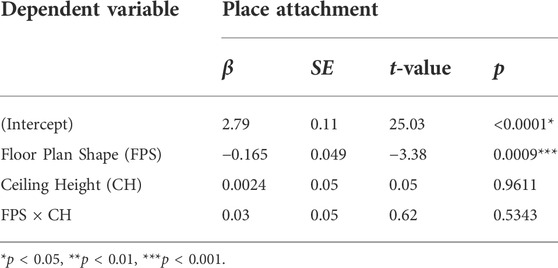
TABLE 5. Results of linear mixed models for place attachment predicted by floor plan shape and ceiling height.
3.2.1 H 1-a. Impacts of ceiling height on place attachment
Among the four dimensions of place attachment used in this study, only place dependence showed statistically significant results associated with ceiling height.
Place Dependence. Ceiling height had a negative impact on place dependence (β = −0.09, t (40.6) = −0.88, p = 0.048). In other words, participants rated higher functional or goal-oriented connections to high ceiling spaces than to low ceiling spaces.
3.2.2 H 1-b. Impacts of floor plan shape on place attachment.
Place Identity. Participants scored higher on place identity for a space with a short, square-like floor plan than the space with a longer floor plan; we observed that floor plan shape has a negative impact on place identity (β = −0.67, t (133.3) = −5.79, p = 0.01).
Place Dependence. Participants scored lower in place dependence for spaces with long floor plans than on those with short floor plans; a significant negative floor plan shape effect on place dependence was found (β = −0.62, t (131.3) = 1.15, p < 0.05).
Personal Sense of Place. Floor plan shape had a strong negative impact on personal sense of place (β = −0.91, t (131.3) = −0.74, p = 0.0003); participants rated significantly higher on personal sense of place with the long floor plan spaces than those with short floor plans. In other words, participants had more affective bonding to a square space than a long rectangular space.
Partial Sense of Place. Participants reported a lower partial sense of place after viewing the long floor plans than they did after viewing short floor plans; floor plan shape showed a negative impact on the partial sense of place (β = 0.62, t (131.3) = −1.42, p < 0.05).
3.3 Hypothesis 2. Moderating effects of individual traits between spatial elements and place attachment
Among gender, age, and personality, only personality showed a negative impact on place attachment (Table 6). Extroversion was found to have a significant negative impact on place attachment (β = −0.59, t (6) = −2.66, p = 0.0086). In other words, more extroverted participants rated lower place attachment regardless of spatial design elements. To be more specific, regarding the subscales of place attachment, extroversion had a negative impact on place identity (β = −0.86, t (6) = −3.7, p = 0.0003) and place dependence (β = −0.67, t (6) = −1.92, p = 0.014). Other individual differences did not have any effect on subscales of place attachment (Tables 6, 7, 8).
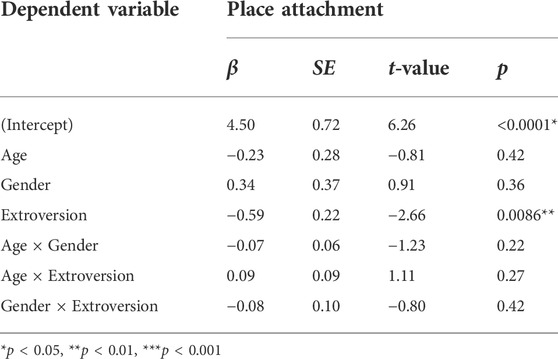
TABLE 6. Results of linear mixed models for place attachment depending on age, gender, and extroversion.

TABLE 7. Results of linear mixed models for place identity and place dependence depending on individual differences (age, gender, and extroversion) regardless of spatial design elements.

TABLE 8. Results of linear mixed models for personal sense of place and partial sense of place depending on individual differences (age, gender, and extroversion) regardless of spatial design elements.
3.3.1 H2-a moderating effects of individual traits between ceiling height and place attachment
H2-a, which hypothesized the effect of ceiling height on place attachment will differ according to age, gender, and personality, was partially supported. Among individual traits, only extroversion showed significant interaction effects with ceiling height on place dependence (Table 9).
Place Dependence. Among individual traits, a significant interaction effect of extroversion and ceiling height was observed (Figure 3). Extroversion had a positive impact on place dependence for high ceiling spaces (β =0 .16, t (41.0) = −0.76, p = 0.039); that is, more extrovert participants felt significantly more functional connections to high ceiling spaces than low ceiling spaces (Table 9).
3.3.2 H 2-b. moderating effects of individual traits between floor plan shape and place attachment
H2-b was fully supported in that the effect of floor plan shape on place attachment was different according to age, gender, and personality (Figure 4).
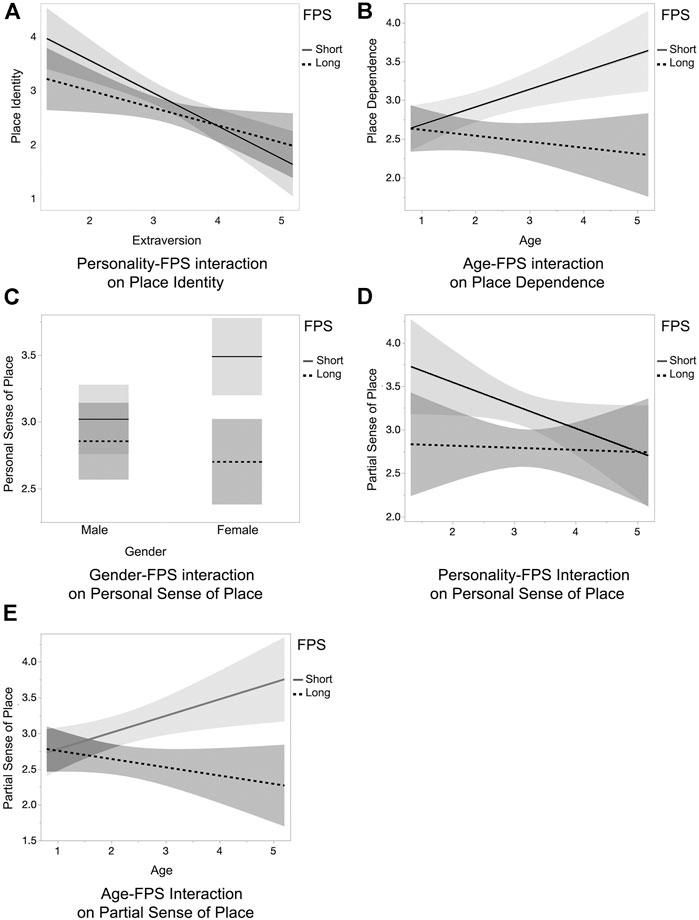
FIGURE 4. Significant interactions between individual traits and floor plan shape (FPS) on place attachment.
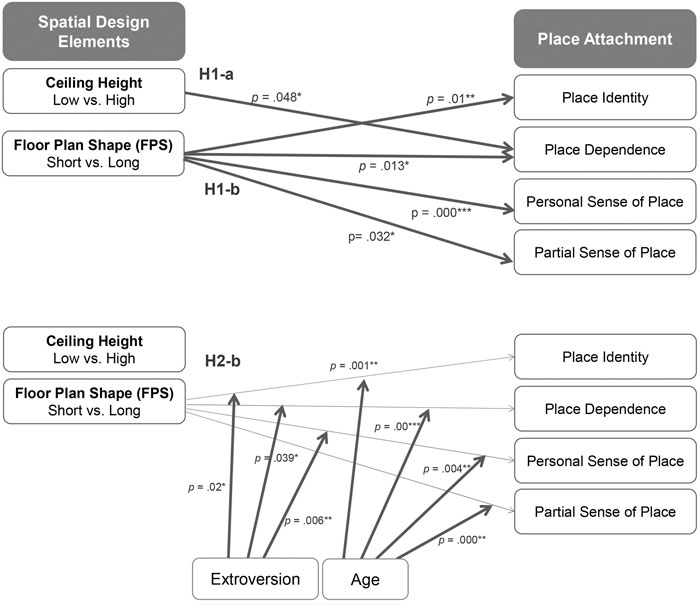
FIGURE 5. The result diagram demonstrates the statistically significant values according to hypotheses.
Place Identity. Extroversion and floor plan shape showed a significant interaction effect on place identity (Figure 4A). Extroversion has a positive impact on place identity for spaces with long floor plan shape (β = 0.17, t (40.8) = −3.21, p = 0.017). In other words, more extroverted people reported higher place identity after viewing spaces with a long floor plan than those with the short one (Table 9).
Place Dependence. There was a significant interaction effect between age and floor plan shape (Figure 4B). Older participants reported higher place dependence after viewing the spaces with long floor plan shapes than with short ones (β = −0.27, t (133.4) = −3.58, p = 0.0005). The older age group thought that the spaces with long floor plan shape, which is rectangular in shape, were more functional than the spaces with short floor plan shape (Table 9).
Personal Sense of Place. Significant interaction effects between individual traits and floor plan shape were found. Gender showed a significant interaction effect with floor plan shape on personal sense of place (Figure 4C). Men reported significantly more affective ties with long floor plan than they did with the short floor plan (β = 0.18, t (41) = 0.76, p = 0.001).
Extroversion also showed a significant interaction effect with floor plan shape (Figure 4D). Participants’ extroversion scores had a positive effect on personal sense of place (β = 0.21, t (40.7) = 3.06, p = 0.006). This means that more extroverted people reported a higher personal sense of place after viewing the rectangular spaces than they did with the square spaces (Table 10).
Partial Sense of Place. There was a significant interaction effect of age and floor plan shape (Figure 4E). Age had a negative effect on partial sense of place (β = −0.17, t (131.4) = −3.74, p = 0.0003). This means that older age group reported a lower partial sense of place after viewing the long floor plans than they did with the short floor plans (Table 10).
4 Discussion and conclusion
The current study addresses the three dimensions of environmental psychology: place, person, and psychological process (Gifford, 2007): place (small living spaces simulated in virtual environments); person (gender-personality user traits); and process (place attachment, a psychological process known to bring psychological benefits). This study explored how fundamental spatial elements and individual traits affected small living space residents’ psychological processes and perceptions of the environment applying VR technology. As shown in the Results section, floor plan shape, gender, age, and personality each had significant impacts on place attachment.
Floor Plan Shape and Place Attachment. We found that participants perceived a square space more positively than a long floor plan with respect to place attachment. This was consistent across all place attachment dimensions measured in the study of place identity, place dependence, personal sense of place, and partial sense of place. A space with a more square-like floor plan (i.e., a short floor plan shape condition) provided a more open look than the other spaces. We can interpret that people feel more connected to a small living space when the plan is more open than they do with a long linear one. This finding could link with previous studies and the acknowledged preference homebuyers have for open floor plans (Brookes and Kaplan, 1972; Maher and von Hippel, 2005). It seems that the psychological benefit from the slightly increased openness with a square-like plan could override the advantage of a long floor plan with separated kitchen and bedroom areas and enhanced privacy.
Personality and Place Attachment. Among many differences between introverts and extroverts, it has been well established that introverts and extroverts have different preferences in terms of stimulation from the surrounding environment (Miller et al., 2020; Yadegari and Alinaghi, 2020).
Prior research indicates that extroverted-introverted personality characteristics stem from differences in physiological development (Li, 2018). According to Li. (2018), extroverts are most likely to be more affected by their interactions with their environment and are possibly more reliant on their surroundings for stimulation or satisfaction. The current study results support this by showing that introverts and extroverts demonstrated significantly different perceptions of the same environment.
Differences between extroverted and introverted personalities could also be explained by another finding from the current study: that introverts and extroverts desire different levels of privacy. Yadegari and Alinaghi’s study (2020) shows that introverts tend to prefer stress-free environments because they do not want to be controlled by other people, whereas extroverts prefer spaces that give them the chance to get attention. In that study, they also found that extroverts need to find a space attractive for representing themselves and for group activities. It is probably because being in an attractive space enhances the extrovert and provides a better setting for social interaction.
The current study results confirm that an individual’s personality is closely related to the surrounding environment. We found a significant difference between extroverts and introverts in their responses to different floor plan shapes in small living spaces. Extroverts reported higher place attachments in the place identity and place dependence dimensions for rectangular spaces that had longer floor plan shapes. Extroverts try to find spaces that give them the chance to get attention (Yadegari & Alinaghi, 2020). The rooms with a short floor plan shape in this study would guarantee a more open-space look and feel than the rooms with long floor plan shapes, and thus possibly lead to less attention for extroverts.
There was a significant effect of high or low extroversion (i.e., extroverts and introverts) on place dependence scores with different ceiling heights. On the basis of our findings, higher extroversion predicts more favorable ratings in place dependence with high ceilings than low ceilings. Considering that place dependence is related to the functionality of the room, rooms with high ceiling heights were considered more functional than rooms with low ceiling heights. Moreover, high ceiling height would be considered to offer more space and freedom than low ceiling height. Given that extroverts need more attention, the high ceiling condition would be considered more functional and give them more space to discharge their energy.
Gender and Personal Sense of place. Personal sense of place is related to short-term positive emotions. In this study, we found that men reported a higher personal sense of place with a rectangular space than a square one, whereas women reported a higher personal sense of place with square-like shorter floor plans than longer floor plans.
These results could be linked to the previous study findings related to gender differences in desired privacy; men have higher levels of desired privacy than females (Yildirim et al., 2007), and they need far more personal space than females do (Gifford, 2014). The square space plan (i.e., a shorter floor plan shape) offers more openness, whereas a longer floor plan provides the space with a higher level of privacy.
The study result implies that people with higher desired privacy would respond to rectangular floor plans more positively than square-like open floor plans because the longer floor plans offer higher privacy.
Age and Place Attachment. Hidalgo and Hernandez (2001) found that the degree of attachment to a physical environment varies with age. Even though the current study was conducted with virtual mock-ups, and not conducted in a real physical environment, it demonstrated similar results. In the current study, we found that different age groups showed different attachments to and perceptions of spaces. This might be interpreted with the previous finding that people of different ages have different spatial depth perceptions (Benson and Yonas, 1973).
Limitations. The experiment was conducted with virtual 3D walkthrough videos. We changed the original research protocol from an immersive VR experiment to online VR videos because of COVID 19 restrictions. Previous studies have demonstrated the reliability of VR as a research tool for predicting real-world experiences and behaviors (Yoon et al., 2010; Hwang et al., 2012). However, to further validate the approach in context, future studies could replicate the experiment in a real environment, an immersive virtual environment, or a mixed reality environment. In addition, a larger sample size would have increased the representative power of the study.
Today’s advanced VR and augmented reality technologies allow viewers to interact with the real-scale environment using a fully immersive head-mounted display. Among the place attachment scales used in this study, partial sense of place is related to long-term and stable bonds with a place. In this study, participants might have felt a lower partial sense of place due to the experimental material and setting. Finally, regarding place attachment, the key concept chosen to measure spatial user experience for the study, it is important to note that place attachment is not only about visual cues and elements, so the feasibility of adding other elements should be considered for future research.
Even though there is growing popularity of small living spaces as a viable housing option and their use as emergency shelters occurs across a broad spectrum of demographic differences, user experiences of such environments have not been empirically studied. In this study, we examined the psychological and emotional responses to different floor plan shapes and ceiling heights in relation to gender and personality. Specifically, we applied the concept of place attachment. To our knowledge, this is the first study to examine the place attachment concept in the context of a simulated virtual environment. Our study found that people tend to feel more connected to a more square-like small space compared with a long rectangular small space when the area is equal. In addition, we found significantly different experiences of small living spaces reported by participants of different genders and extrovert-introvert personalities, indicating the need for user trait considerations to provide more satisfying resident experiences.
This study provides two important implications. For practical implications, it could provide useful information to decision-makers such as developers and policymakers who are interested in improving the quality of tiny homes. Ultimately, it could offer end users of small affordable housing or refuge shelters more comfortable experiences. For theoretical implications, the study uses a new approach by applying place attachment as a measurement while examining viewers’ experiences of small living spaces in a virtual environment. This study analyzed the perceptions toward different design elements of virtual environments with place attachment, which is a behavioral measurement. In future work, the scope can be extended to include other design elements, such as furniture and windows, and additional user traits. Finally, advanced immersive virtual environments utilizing VR and augmented reality technologies offer lifelike experiences so that researchers will not have to question their reliability. As the technology becomes more sophisticated, more researchers for spatial user experience studies should consider the opportunities to tackle problems that were not accessible otherwise.
Data availability statement
The raw data supporting the conclusions of this article will be made available by the authors, without undue reservation.
Ethics statement
The studies involving human participants were reviewed and approved by Institutional Review Board for Human Participant Research, Cornell Univeresity. The patients/participants provided their written informed consent to participate in this study.
Author contributions
SYY conceived of the presented idea. SYY and SYL developed the theory. SYL conducted the experiments, and SYY supervised the analytical methods. Both authors contributed to the final version of the manuscript.
Conflict of interest
The authors declare that the research was conducted in the absence of any commercial or financial relationships that could be construed as a potential conflict of interest.
Publisher’s note
All claims expressed in this article are solely those of the authors and do not necessarily represent those of their affiliated organizations, or those of the publisher, the editors and the reviewers. Any product that may be evaluated in this article, or claim that may be made by its manufacturer, is not guaranteed or endorsed by the publisher.
References
Allen, T. J., and Gerstberger, P. G. (1973). A field experiment to improve communications in a product engineering department: The nonterritorial office. Hum. Factors 15 (5), 487–498. doi:10.1177/001872087301500505
Baistatou, A. B., Florentin, V., and Yvonne, N. D.-T. (2022). Virtual reality to evaluate the impact of colorful interventions and nature elements on spontaneous walking, gaze and emotion. Front. Virtual Real. 2, 17. doi:10.3389/frvir.2022.819597
Barrick, M. R., and Mount, M. K. (1991). The big five personality dimensions and job performance: A meta-analysis. Pers. Psychol. 44 (1), 1–26. doi:10.1111/j.1744-6570.1991.tb00688.x
Benson, C., and Yonas, A. (1973). Development of sensitivity to static pictorial depth information. Percept. Psychophys. 13 (3), 361–366. doi:10.3758/BF03205786
Brookes, M., and Kaplan, A. (1972). The office environment: Space planning and affective behavior. Hum. Factors 14 (5), 373–391. doi:10.1177/001872087201400502
Digman, J. (1990). Personality structure: Emergence of the five-factor model. Annu. Rev. Psychol. 41, 417–440. doi:10.1146/annurev.ps.41.020190.002221
Doggett, R., Sander, E. J., Birt, J., Ottley, M., and Baumann, O. (2021). Using virtual reality to evaluate the impact of room Acoustics on cognitive performance and well-being. Front. Virtual Real. 2. doi:10.3389/frvir.2021.620503
Evans, G. W., Lepore, S. J., and Schroeder, A. (1996). The role of interior design elements in human responses to crowding. J. Personality Soc. Psychol. 70 (1), 41–46. doi:10.1037/0022-3514.70.1.41
Evans, G. W., Wells, N. M., and Moch, A. (2003). Housing and mental health: A review of the evidence and a methodological and conceptual critique. J. Soc. Issues 59 (3), 475–500. doi:10.1111/1540-4560.00074
Evans, K. (2018). Integrating tiny and small homes into the urban landscape: History, land use barriers and potential solutions. J. Geogr. Reg. Plann. 11 (3), 34–45. doi:10.5897/jgrp2017.0679
Evans, K. (2021). Overcoming barriers to tiny and small home urban integration: A comparative case study in the carolinas. J. Plan. Educ. Res. 41 (3), 270–281. doi:10.1177/0739456X18788938
Gifford, R. (2014). Environmental psychology matters. Annu. Rev. Psychol. 65, 541–579. doi:10.1146/annurev-psych-010213-115048
Gifford, R. (2007). Environmental psychology: Principles and practice. 4th ed. Colville, WA: Optimal Books.
Gifford, R., Steg, L., and Reser, J. P. (2011). “Environmental psychology,” in IAAP handbook of applied psychology (Wiley-Blackwell), 440–470. doi:10.1002/9781444395150.ch18
Gormly, J. (1983). Predicting behavior from personality trait scores. Pers. Soc. Psychol. Bull. 9 (2), 267–270. doi:10.1177/0146167283092011
Harrison, X. A., Donaldson, L., Correa-Cano, M. E., Evans, J., Fisher, D. N., Goodwin, C. E. D., et al. (2018). A brief introduction to mixed effects modelling and multi-model inference in ecology. PeerJ 6 (5), 1–3. doi:10.7717/peerj.4794
Hidalgo, M. C., and Hernández, B. (2001). Place attachment: Conceptual and empirical questions. J. Environ. Psychol. 21 (3), 273–281. doi:10.1006/jevp.2001.0221
Hundert, A. T., (1969). “Physical space and organizational behavior: A study of an office landscape,” in Proceedings of the 77th annual convention of the American psychological association (Wuhan, China: APA), 601–602.
Hwang, J., Yoon, S. Y., and Bendle, L. J. (2012). Desired privacy and the impact of crowding on customer emotions and approach-avoidance responses: Waiting in a virtual reality restaurant. Int. J. Contemp. Hosp. Manag. 24 (2), 224–250. doi:10.1108/09596111211206150
ICC (2018). 2018 international residential code. ICC (distributed by Cengage Learning)Available at: https://bbtinyhouses.com/appendix-q-adopted-in-ma/.
Jackson, A., Callea, B., Stampar, N., Sanders, A., De Los Rios, A., and Pierce, J. (2020). Exploring tiny homes as an affordable housing strategy to ameliorate homelessness: A case study of the dwellings in tallahassee, fl. Int. J. Environ. Res. Public Health 17 (2), 661. doi:10.3390/ijerph17020661
Kaltenborn, B. P. (1997). Recreation homes in natural settings: Factors affecting place attachment. Norsk Geografisk Tidsskrift - Nor. J. Geogr. 51 (4), 187–198. doi:10.1080/00291959708542842
Kaya, N., and Weber, M. J. (2003). Cross-cultural differences in the perception of crowding and privacy regulation: American and Turkish students. J. Environ. Psychol. 23 (3), 301–309. doi:10.1016/S0272-4944(02)00087-7
Krista, E. (2018). Integrating tiny and small homes into the urban landscape: History, land use barriers and potential solutions. J. Geogr. Reg. Plann. 11 (3), 34–45. doi:10.5897/jgrp2017.0679
Kyle, G., Graefe, A., Manning, R., and Bacon, J. (2004). Effects of place attachment on users’ perceptions of social and environmental conditions in a natural setting. J. Environ. Psychol. 24 (2), 213–225. doi:10.1016/j.jenvp.2003.12.006
Li, D., and Han, X. (2021). Assessing the influence of goal pursuit and emotional attachment on customer engagement behaviors. J. Retail. Consumer Serv. 59, 102355. doi:10.1016/J.JRETCONSER.2020.102355
Li, Z. (2018). Advances in social science. New York and London: The Guilford Press, 176.Investigation and analysis on the characteristics of five personalities of the depressed patients
Lowry, P. (1993). Privacy in the preschool environment: Gender differences in reaction to crowding. Children’s Environ. 10 (2), 130–139. Available at: https://www.jstor.org/stable/41514887?seq=1#metadata_info_tab_contents (Accessed: January 29, 2022).
Magezi, D. A. (2015). Linear mixed-effects models for within-participant psychology experiments: An introductory tutorial and free, graphical user interface (LMMgui). Front. Psychol. 6, 2. doi:10.3389/fpsyg.2015.00002
Maher, A., and von Hippel, C. (2005). Individual differences in employee reactions to open-plan offices. J. Environ. Psychol. 25 (2), 219–229. doi:10.1016/j.jenvp.2005.05.002
Mangold, S., and Zschau, T. (2019). In search of the “good life”: The appeal of the tiny house lifestyle in the USA. Soc. Sci. 8, 1–26. doi:10.3390/SOCSCI8010026
Meagher, B. R., and Cheadle, A. D. (2020). Distant from others, but close to home: The relationship between home attachment and mental health during COVID-19. J. Environ. Psychol. 72, 101516. doi:10.1016/J.JENVP.2020.101516
Miller, J. R., Cheung, A., Novilla, L. K., and Crandall, A. (2020). Childhood experiences and adult health: The moderating effects of temperament. Heliyon 6, e03927. doi:10.1016/J.HELIYON.2020.E03927
Neo, J. R. J., Won, A. S., and Shepley, M. M. (2021). Designing immersive virtual environments for human behavior research. Front. Virtual Real. 2. doi:10.3389/frvir.2021.603750
Olick, D. (2018). Tiny homes can mean big costs, especially depending on where you liv. Available at: https://www.cnbc.com/2021/08/18/tiny-homes-can-mean-big-costs-especially-depending-on-where-you-live.html.
Penfold, H., Waitt, G., and McGuirk, P. (2019). Portrayals of the tiny house in electronic media: Challenging or reproducing the Australian dream home. Aust. Plan. 55 (3–4), 164–173. doi:10.1080/07293682.2019.1632360
Pervin, L. A., and John, O. P. (1999). Handbook of personality : Theory and research. London: Taylor & Francis Online, Housing Studies Journal, 738.
Portman, M. E., Natapov, A., and Fisher-Gewirtzman, D. (2015). To go where no man has gone before: Virtual reality in architecture, landscape architecture and environmental planning. Comput. Environ. Urban Syst. 54, 376–384. doi:10.1016/j.compenvurbsys.2015.05.001
Proshansky, H. M., Fabian, A. K., and Kaminoff, R. (1983). Place-identity: Physical world socialization of the self. J. Environ. Psychol. 3 (1), 57–83. doi:10.1016/S0272-4944(83)80021-8
Raymond, C. M., Brown, G., and Weber, D. (2010). The measurement of place attachment: Personal, community, and environmental connections. J. Environ. Psychol. 30 (4), 422–434. doi:10.1016/J.JENVP.2010.08.002
Rollings, K. A., and Evans, G. W. (2019). Design moderators of perceived residential crowding and chronic physiological stress among children. Environ. Behav. 51 (5), 590–621. doi:10.1177/0013916518824631
Scannell, L., and Gifford, R. (2017). The experienced psychological benefits of place attachment. J. Environ. Psychol. 51, 256–269. doi:10.1016/J.JENVP.2017.04.001
Schreyer, R., Jacob, G., and White, R. (1981). “Environmental meaning as a determinant of spatial behaviour in recreation,” in Roceedings of the applied geography conferences.
Shearer, H., and Burton, P. (2021). Tiny houses: Movement or moment? Housing Studies [Preprint. doi:10.1080/02673037.2021.1884203
Stamps, A. E. (2011). Effects of area, height, elongation, and color on perceived spaciousness. Environ. Behav. 43 (2), 252–273. doi:10.1177/0013916509354696
Stokols, D., and Shhumaker, S. A. (1981). “People in places: A transactional view of settings,” in Cognition social behaviour and the environment. Editor HARVEY (Mahwah: Lawrence Erlbaum Assoc).
Wells, M., and Thelen, L. (2016). What does your workspace say about you? Environ. Behav. 34 (3), 300–321. doi:10.1177/0013916502034003002
Yadegari, Z., and Alinaghi, B. (2020). The effect of introversion and extroverts of individuals in the socialization of public space. Tech. Soc. Sci. J. 3, 82–93. Available at: https://heinonline.org/HOL/Page?handle=hein.journals/techssj3&id=82&div=&collection= (Accessed: April 18, 2022).
Yildirim, K., Akalin-Baskaya, A., and Celebi, M. (2007). The effects of window proximity, partition height, and gender on perceptions of open-plan offices. J. Environ. Psychol. 27 (2), 154–165. doi:10.1016/J.JENVP.2007.01.004
Yoon, S. Y., Oh, H., and Cho, J. Y. (2010). Understanding furniture design choices using a 3D virtual showroom. J. Inter. Des. 35 (3), 33–50. doi:10.1111/j.1939-1668.2010.01041.x
Zahn, G. L. (2016). Face-to-Face communication in an office setting: The effects of position, proximity, and exposure. Commun. Res. 18 (6), 737–754. doi:10.1177/009365091018006002
Keywords: small living spaces, virtual environment, place attachment, ceiling height, floor plan shape, tiny home
Citation: Lee S-Y and Yoon S-Y (2022) Effects of gender and personality on experience of small living spaces: Ceiling height and floor plan shape in virtual environment. Front. Virtual Real. 3:958829. doi: 10.3389/frvir.2022.958829
Received: 01 June 2022; Accepted: 09 September 2022;
Published: 26 September 2022.
Edited by:
Weiya Chen, Huazhong University of Science and Technology, ChinaReviewed by:
Huaxian Wan, Southwest Jiaotong University, ChinaJi Young Cho, Kyung Hee University, South Korea
Copyright © 2022 Lee and Yoon. This is an open-access article distributed under the terms of the Creative Commons Attribution License (CC BY). The use, distribution or reproduction in other forums is permitted, provided the original author(s) and the copyright owner(s) are credited and that the original publication in this journal is cited, in accordance with accepted academic practice. No use, distribution or reproduction is permitted which does not comply with these terms.
*Correspondence: So-Yeon Yoon, c3k0OTJAY29ybmVsbC5lZHU=
 Seo-Young Lee
Seo-Young Lee So-Yeon Yoon
So-Yeon Yoon
